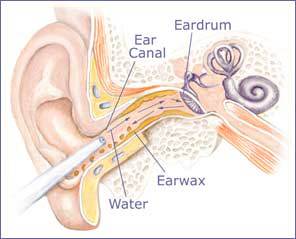Table of Contents
ToggleEar Irrigation
Ear irrigation is a medical procedure used to remove excess earwax or foreign objects from the ear canal. It is performed to maintain ear health and restore hearing. Here are guidelines for conducting ear irrigation:

Assessment and Patient History
- Begin by assessing the patient’s medical history, focusing on any ear-related issues, allergies, or previous ear surgeries.
Informed Consent:
- Explain the procedure to the patient, detailing its purpose and potential sensations. Obtain informed consent before proceeding.
Purposes:
- The primary purpose of ear irrigation is to remove earwax obstructing the ear canal or to extract foreign objects lodged in the ear canal.
- Commonly performed for individuals experiencing wax buildup leading to impaired hearing and irritation of the outer ear canal.
Objective:
- To cleanse the ear canal of discharge, soften and remove impacted cerumen (earwax), or dislodge a foreign object.
Indication:
- Cerumen impaction (earwax buildup) or the presence of a foreign body in the ear.
Contraindication:
- Contraindicated when the auditory canal is obstructed by a vegetable foreign body, such as a pea, bean, or corn kernel, as these can absorb moisture and swell.
- Contraindicated in the presence of a cold, fever, ear infection, unknown injury, or rupture of the tympanic membrane (eardrum).
Nursing Alert:
- Avoid dropping or squirting solution directly onto the eardrum.
- Do not use more than 500 ml of solution.
- If the tympanic membrane is ruptured, consult with the doctor before irrigating.
- Monitor the solution’s temperature carefully.
- Forceful instillation of the solution can rupture the tympanic membrane.
- Stop the procedure if the patient experiences pain or dizziness.
Charting:
- Document the date and type of irrigation, specifying the ear that was irrigated.
- Record the volume and type of solution used, along with the appearance of the return flow.
After Care:
- Discard equipment in the appropriate area.
- Wash hands thoroughly.
Equipment:
- Prescribed irrigating solution warmed to 37°C (98.6°F).
- Irrigation set (container and irrigating or bulb syringe).
- Emesis basin.
- Cotton-tipped applicator.
- Cotton balls.
- Waterproof pad.
Nursing Interventions | Rationale
- Explain the procedure to the client.
- Rationale: Explanation facilitates cooperation and provides reassurance for the patient, ensuring their understanding and cooperation.
- Assemble the equipment. Protect the client and bed linens with a moisture-proof pad.
- Rationale: This provides an organized approach to the task, ensuring all necessary equipment is ready. The moisture-proof pad protects the bed linens from potential spills.
- Wash your hands.
- Rationale: Handwashing is essential to deter the spread of microorganisms, maintaining aseptic conditions during the procedure.
- Have the client sit up or lie with the head tilted toward the side of the affected ear. Have the client support a basin under the ear to receive the irrigating solution.
- Rationale: Gravity causes the irrigating solution to flow from the ear to the basin, aiding in the effective removal of debris or earwax.
- Clean the pinna and the meatus at the auditory canal as necessary with normal saline or the irrigating solution.
- Rationale: Cleaning materials lodged on the pinna and meatus prevents them from being washed into the ear during the irrigation process.
- Fill the bulb syringe with solution. If an irrigating container is used, allow air to escape from the tubing.
- Rationale: Air forced into the ear canal is noisy and unpleasant for the client. Proper filling of the syringe and tubing ensures a smooth and comfortable procedure.
- Straighten the auditory canal by pulling the pinna down and back for an infant and up and back for an adult.
- Rationale: Straightening the ear canal aids in allowing the solution to reach all areas of the ear easily, ensuring effective irrigation.
- Direct a steady, slow stream of solution against the roof of the auditory canal, using only sufficient force to remove secretions. Do not occlude the auditory canal with the irrigating nozzle. Allow the solution to flow out unimpeded.
- Rationale: Directing the solution at the roof of the canal prevents injury to the tympanic membrane. Continuous in-and-out flow helps prevent pressure build-up in the canal.
- When the irrigation is completed, place a cotton ball loosely in the auditory meatus, and have the client lie on the side of the affected ear on a towel or an absorbent pad.
- Rationale: The cotton ball absorbs excess fluid, and gravity allows the remaining solution in the canal to escape, completing the ear irrigation process effectively.
Read more: BSc/RN/PHN/RM Practical Questions
Read more: Body Sculpting Massage





